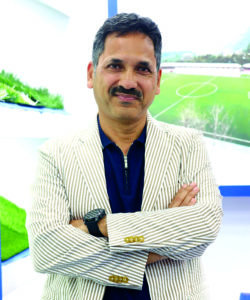Nasir Ali, Founder & CEO, Gallant Sports & Infra
By Monojit Mandal
 At nearly 5,000 feet above sea level, Shillong has always been a city where football breathes through the mist and echoes down every hillside lane. Schoolboys chase a ball on dew-soaked grounds, neighbourhood clubs polish raw talent on makeshift fields, and whole communities gather in the rain to cheer their teams.
At nearly 5,000 feet above sea level, Shillong has always been a city where football breathes through the mist and echoes down every hillside lane. Schoolboys chase a ball on dew-soaked grounds, neighbourhood clubs polish raw talent on makeshift fields, and whole communities gather in the rain to cheer their teams.
It is no wonder the city is called the “football capital of the North East.” But now a bigger question looms: can Shillong turn this undying passion into something larger—can it truly become India’s high-altitude sports capital?For Nasir Ali, Director of Gallant Sports & Infra Pvt Ltd, the answer begins with infrastructure. “We’ve proven in Arunachal Pradesh and Manipur that world-class facilities can rise even in the toughest terrains, and Meghalaya deserves no less” he said with quiet conviction in an exclusive tete-a-tete with The Shillong Times.
Gallant Sports has already built a reputation in the region by delivering FIFA-certified fields and stadiums of international standard—often in places where few believed it could be done. The high-altitude Tawang Stadium in Arunachal Pradesh is perhaps the most striking example. And now, with Shillong on their radar, the company is turning towards a city that has given India generations of footballers and still thrums with grassroots energy.
What makes Shillong special? Ali doesn’t hesitate. “It isn’t just a football-loving city, it’s a football ecosystem,” he explains. “The history, the player base, the audience—it’s all already here.” For Gallant, that means a rare opportunity: investing in infrastructure that doesn’t have to invent culture, only nurture it.
Infrastructure, after all, is more than steel and turf. It shapes careers, binds communities, and keeps dreams alive. In Meghalaya, where monsoon rains often wash away practice sessions, the promise of all-weather, drainable pitches could be a game-changer. “Talent thrives when given the right environment,” Ali says. “FIFA-certified fields ensure that a boy in Shillong doesn’t have to leave home to know what a professional pitch feels like.”
That sense of staying rooted—of training in one’s own hills while touching international standards—lies at the heart of Gallant’s vision. For too long, young athletes from Meghalaya have been forced to migrate to metros in search of facilities. Ali believes the tide can turn once professional-grade infrastructure is available locally. “They can train at home, stay connected to their community, and still get the exposure they need. It creates a sustainable ecosystem.”The plan, importantly, isn’t limited to giant stadiums. Smaller community fields, futsal courts, and compact training grounds are also part of the blueprint. “That’s where the real culture is nurtured,” Ali says, almost like a coach recalling the first time a child kicks a ball. “Clubs, schools, local organisers—if they have access to quality, affordable spaces, grassroots sports will flourish.”
And it’s not just football. Ali and his team have noticed a growing appetite for athletics, basketball, and even indigenous sports across Meghalaya. Multi-sport complexes, they argue, are the way forward. Imagine the hills hosting not just footballers, but sprinters, hoopers, and traditional athletes—all under the same roof.Of course, every dream here comes with its challenges. Land availability and ecological concerns are always at the forefront. Gallant, Ali insists, is mindful of this. “Sustainability is part of our design philosophy. We choose land carefully, use eco-friendly materials, and work with local authorities. The goal is always to enhance, not disrupt.”
Already, signs of Shillong’s readiness are visible. The city has hosted I-League and Durand Cup matches, proving it can stage football at a high level. But to become a regular name on the national calendar—and maybe even the international one—Ali says upgraded facilities for players and fans alike are essential. Modern training centres, better spectator amenities, and stadiums built to global standards could transform Shillong from a footballing city into a true sporting hub.
Interestingly, the vision stretches beyond sport. Ali points to the natural advantage of Shillong’s altitude. “The terrain here is perfect for natural conditioning. High-altitude training centres could even position Meghalaya as a sports tourism hub,” he suggests, drawing parallels to Gallant’s work in Tawang.
The timing, too, seems right. With NorthEast United FC made Shillong its second home ground, the demand for professional infrastructure will only grow. Gallant hopes to be part of that transformation—bridging the gap between Shillong’s footballing soul and the modern stage it deserves.



